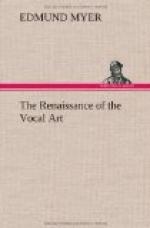We will take for our first study a simple arpeggio, using the syllables Ya ha, thus:
[Illustration: FIRST STUDY. Ya, ha....]
We use Ya on the first tone, because when sung freely it helps to place the tone well forward. Ya is pronounced as the German Ja. We use ha on all other tones of this study for the reason that it is the natural staccato of the voice. Think it and sing it “in glossic” or phonetically, thus: hA, very little h but full, inflated, expanded A. A full explanation for the use of Ya and ha may be found in “Position and Action in Singing,” page 117. All the studies given in this little work for the illustration and study of the movements of our system should be sung on all keys as high and as low as they can be used without effort and without strain.
It has been said that “the production of the human voice is the effect of a muscular effort born of a mental cause.” Therefore it is important to know what to think and how to think it.
We say, put yourself and keep yourself constantly upon a level with the tone, mentally, physically and emotionally. For the present we have to do with the mental and physical only.
Stand in an easy, natural manner, the hands and arms hanging loosely by the sides. You desire to sing the above exercise. Turn the palms of the hands up in a free, flexible manner, and lift the hands up and out a little, not high, not above the waist line. When moving the hands up and out, move the body from the hips up and out in exactly the same manner and proportion. The hands and arms must not move faster than the body; the body must move rhythmically with the arms. This rhythmical movement of body and arms is highly important. In moving, the sensation is as though the body were lifted lightly and freely upon the palms of the hands. The hands say to the body, “Follow us.” In this way, lift, expand, and let go. Do not raise the shoulders locally. The movement is from the hips up. The entire body expands easily and freely by letting go all contraction of muscle. Do not first lift, and after lifting expand, and then finally try to let go, as is the habit of many; but lift, and when lifting expand, and when lifting and expanding let go as directed. Three thoughts in one movement—three movements in one—lifting, expanding, and letting go simultaneously as one movement, which in fact it must finally become. This is the only way in which it is possible to secure all true conditions of tone.
With this thought in mind, and having tried the movement without singing, sing the above exercise. Start from repose, as described, and by using the hands and body in a free, flexible manner, move to what you might think should be the level of the first tone. Just when you reach the level of the first tone let the voice sing. Move up with the arpeggio to the highest note, using hands, body, and voice with free, flexible action; then move body and hands with the voice down to the lowest note of the arpeggio; when the last tone is sung go into a position of repose.




